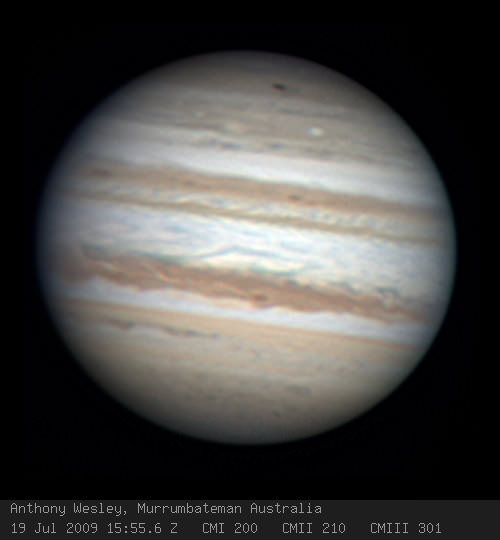[/caption]
Amateur astronomer Anthony Wesley from Canberra, Australia captured an image of Jupiter on July 19 showing a possible new impact site. Anthony’s image shows a new dark spot in the South Polar Region of Jupiter, at approximately 216° longitude in System 2. It looks very similar to the impact marks made on Jupiter when comet Shoemaker-Levy 9 crashed into the gas giant in 1994. (But read the Bad Astronomer’s post that the black spot could also be weather.)
UPDATE (7/20): It has been confirmed this is an impact on Jupiter. Mike Salway shared the news Glenn Orton from JPL has imaged the Jupiter black spot with the NASA Infrared Telescope and he has confirmed it’s an impact.
The list below shows the times (in UT) when the black spot will be visible again (generated in WinJupos by Hans-Joerg Mettig), and found on the Mike Salway’s Ice In Space website.
2009 Jul 19 06:09 ( 216°) 16:05 ( 216°)
2009 Jul 20 02:00 ( 216°) 11:56 ( 216°) 21:52 ( 216°)
2009 Jul 21 07:47 ( 216°) 17:43 ( 216°)
2009 Jul 22 03:38 ( 216°) 13:34 ( 216°) 23:30 ( 216°)
2009 Jul 23 09:25 ( 216°) 19:21 ( 216°)
2009 Jul 24 05:16 ( 216°) 15:12 ( 216°)
2009 Jul 25 01:08 ( 216°) 11:03 ( 216°) 20:59 ( 216°)
2009 Jul 26 06:54 ( 216°) 16:50 ( 216°)
2009 Jul 27 02:45 ( 216°) 12:41 ( 216°) 22:37 ( 216°)
2009 Jul 28 08:32 ( 216°) 18:28 ( 216°)
2009 Jul 29 04:23 ( 216°) 14:19 ( 216°)2009
Jul 30 00:15 ( 216°) 10:10 ( 216°) 20:06 ( 216°)
2009 Jul 31 06:01 ( 216°) 15:57 ( 216°)
If you get the opportunity to observe or image this potential new discovery, please do.
On his observing blog, Anthony said he began observing Jupiter at approximately 11pm local time (1300UTC), using a 14.5″ Newtonian telescope. “I’d noticed a dark spot rotating into view in Jupiter’s south polar region and was starting to get curious,” he wrote. “When first seen close to the limb (and in poor conditions) it was only a vaguely dark spot, I thought likely to be just a normal dark polar storm. However as it rotated further into view, and the conditions also improved, I suddenly realized that it wasn’t just dark, it was black in all channels, meaning it was truly a black spot.”
First he thought it might be a dark moon (like Callisto) or a moon shadow, but it was in the wrong place and the wrong size. “Also I’d noticed it was moving too slow to be a moon or shadow. As far as I could see it was rotating in sync with a nearby white oval storm that I was very familiar with – this could only mean that the back feature was at the cloud level and not a projected shadow from a moon. I started to get excited.”
Hard-Hat tip to Mike Salway for alerting UT to the news.


I don’t believe a purely weather-related cause has been ruled out yet.
I’m sure others are looking at any recent cometary or asteroid images which might indicate an impact. Any word on that? aka there must be some recent images which might show an Jovian interloper? THAT would be interesting to see!
I would like to have a look if my galileoscope would come, grr.
Its possible that an impactor might have hit jupiter from behind, which would keep us from seeing the impact.
True, from directly behind Jupiter it may have been hidden by Jupiter before impact.
It’s been confirmed that it is indeed an impact site!!
Well done Anthony, terrific news! Fantastic reward for all your hard work over the past few years!
Requesting observatory access to image this object. Really excited to learn what it is. Though in the image provided it does look like it may just be weather related….I don;t know, lets all find out!
Great Work. I wonder if this was caught on its first pass into view or if anyone else may have caught earlier images from the previous day. I am wondering what the mass of the object was based on the size of the impact compared to the Shoemaker-Levy impacts. It would be wonderful if someone was able to find the impactor on old images, but this is unlikely. I have to wonder now just how often Jupiter gets hit as it seems unlikely that the last two impacts are an incredibly rare coincidence. As such one has to reconsider Jupiter’s role in proetcting the inner solar system from impacts.
Nice to see amateur astronomy is not only alive, but thriving! =D
I may possibly have video of the object that has hit jupiter